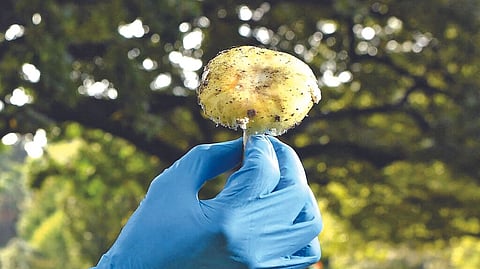

Foragers around the world hunt for wild mushrooms to bring their earthy, nutty, meaty flavours to the table. But every so often, people mistake a potentially lethal variety for the edible ones. A mushroom called the death cap — Amanita phalloides — and dozens of related species containing the same toxin, alpha amanitin, account for the vast majority of mushroom-poisoning deaths.
And many scientists have tried to find a quick remedy. “There’s no antidote,” said Terrence Delaney, a plant biologist and mycologist at the University of Vermont who studies the toxin profiles of a related mushroom called the destroying angel.
In the past, such poisoning was fatal in more than half of the cases, but today about 85 to 90 percent of people survive. The main treatment is hydration, because the toxin is excreted in urine, Dr. Delaney said, and also includes electrolytes and substances to protect the liver. “But a lot of people don’t get better, and the only effective therapy is a liver transplant,” he said.
Over the years, researchers have proposed and tested several treatments, Dr. Delaney said, adding, “To be honest, none of those are convincing.” Alpha amanitin wreaks havoc in the body by mucking up the cells’ ability to make messenger RNA. Messenger RNA builds proteins, and without new proteins, the cell’s machinery grinds to a halt. As the toxin circulates in the body, it causes extensive damage to the liver.
But researchers have very little idea of how exactly the toxin does its dirty work, said Qiaoping Wang, a pharmacologist and toxicologist at Sun Yat-Sen University in Shenzhen, China.
Dr. Wang and his colleagues are not foragers themselves. They are, however, in the business of examining the genome to look for chains of biological events set off by toxins, as well as molecules that block them. In a study published on Tuesday in Nature Communication, they reported finding a promising molecule that seemed to prevent some of the toxic effects of alpha amanitin.
The researchers first used CRISPR, the gene-editing technology, to create human cells with thousands of specific genes knocked out, one by one. They then swamped the cells with alpha amanitin and tracked which ones continued to thrive. If the cells’ lives were rosier when a specific gene was deactivated, they reasoned, that gene might be involved in fighting off the toxin. They narrowed in on one gene, STT3B, that seemed especially critical to toxicity.
Next, the researchers used computer modelling to search for compounds approved by the U.S. Food and Drug Administration that might block STT3B, coming up with 34 possible drugs. All but one fell away in further tests on cells.
The remaining compound, called indocyanine green (ICG), is a dye widely used to take images of liver and heart function. When Dr. Wang and his team injected the toxin into mice, followed by ICG, the animals’ recovery improved and the liver damage decreased significantly.
“The exact mechanism is still unknown,” Dr. Wang said. But his team’s work so far suggests that the STTB3 gene somehow helps alpha amanitin enter cells, and that ICG prevents this step.
Visit news.dtnext.in to explore our interactive epaper!
Download the DT Next app for more exciting features!
Click here for iOS
Click here for Android